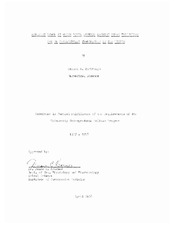| dc.contributor.advisor | Kraemer, Duane C. | |
| dc.creator | Yarbrough, Steven H. | |
| dc.date.accessioned | 2022-06-30T16:13:52Z | |
| dc.date.available | 2022-06-30T16:13:52Z | |
| dc.date.issued | 1978 | |
| dc.identifier.uri | https://hdl.handle.net/1969.1/CAPSTONE-YarbroughS_1978 | |
| dc.description | Program year: 1977-1978 | en |
| dc.description | Digitized from print original stored in HDR | en |
| dc.description.abstract | This experiment is designed to determine the earliest stage at which mouse embryos lacking zonae pellucidae, when transferred to recipient uteri, produce viable offspring.
Donor mice were superovulated using Pregant Hare Serum Gonadotropin (PMSG) and Human Chorionic Gonadotropin (HCG). On the fourth day post-coitum, each mouse was euthanized by cervical dislocation and uteri removed by blunt dissection, Embryos were flushed from each horn into embryonic watch glasses using Phosphate Buffered Saline (PBS). The stage of development was consistantly between late morula and early blastocyst. The embryos were divided into two equivalent groups. The zona pellucida was removed from one group using pronase. Recipients were superovulated to be synchronous with donors and were mated with vascectomized males to induce pseudopregnancy and prevent maternal embryos from developing. Each recipient was anesthetized with Inovar (10%) and a mid-ventral laparotomy performed to expose the uterus. Each recipient recieved either normal or zona-free embryos. Some recipients were allowed to go to term and others terminated after ten days to detect fetal development.
The technique was prooven adequate since a pregnancy did result in a control transfer with normal embryos, but, no pregnancies were detected in zona-free transfers. | en |
| dc.format.extent | 24 pages | en |
| dc.format.medium | electronic | en |
| dc.format.mimetype | application/pdf | |
| dc.subject | zonae pellucidae | en |
| dc.subject | mouse embryos | en |
| dc.subject | embryo transfer | en |
| dc.subject | Pregnant Hare Serum Gonadotropin | en |
| dc.subject | Human Chorionic Gonadotropin | en |
| dc.title | Earliest Stage at Which Mouse Embryos Lacking Zonae Pellucidae Can Be Successfully Transferred to the Uterus | en |
| dc.type | Thesis | en |
| thesis.degree.department | Biomedical Science | en |
| thesis.degree.grantor | University Undergraduate Fellows | en |
| thesis.degree.level | Undergraduate | en |
| dc.type.material | text | en |


